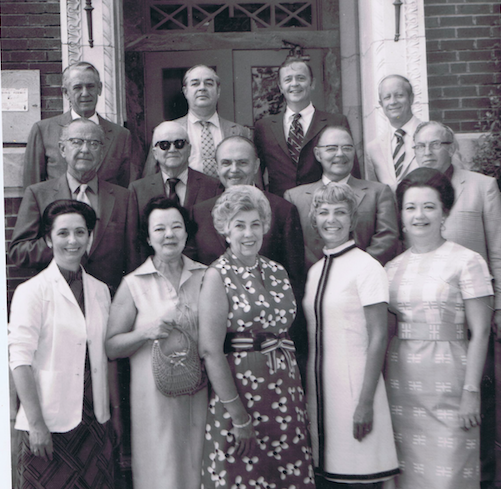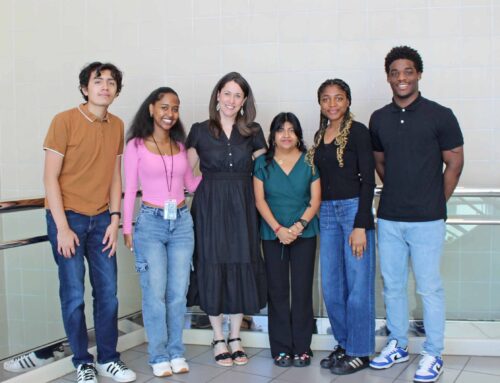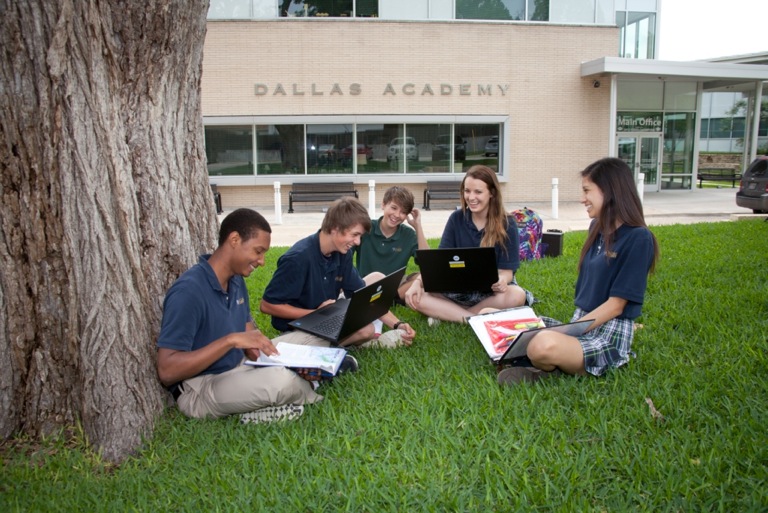
Modern-day students at Dallas Academy enjoy a college-like campus off Tiffany Way. (Photo courtesy of Dallas Academy).
Dorothy and Wallace Savage and Dallas Academy, the first special education school in the City.
A dream Dorothy Savage often spoke of, in which she arduously climbed a mountain, could easily have be used as a metaphor for the pursuit of special education.
“As soon as she’d get to the top, there’d be another mountain to climb,” says her eldest daughter, Virginia Savage McAlester, seated in the bright sunroom of the family’s historic Swiss Avenue home. “She always felt it was God speaking to her, telling her there will always be more obstacles to overcome in life, but you have to just keep going.”
Dorothy Savage wasn’t a woman who saw problems; she saw questions in need of answers. When the historic homes in her beloved neighborhood were getting torn down, she took a stand to slow the unwanted wave of change by launching Preservation Dallas, which created the Swiss Avenue Historic District.
So when her daughter, who was born deaf, was diagnosed with cerebral palsy, Dorothy Savage was hyper-vigilant about helping her youngest navigate the world with disabilities. Named for her mother, Dorothy “Dotsy” Savage was born in 1946, well before the Education For All Handicapped Children Act of 1975 and a generation before the modern standards of the 2004 Individuals with Disabilities Education Act.
At the time, Dallas did have a school for the deaf, but it was not the right fit for Dotsy, whose cerebral palsy added an extra level of disability.
Across the nation in that era, little emphasis was put on students like Dotsy, whose mental faculties were sharp, but who struggled with movement and communication. Without a suitable option for their daughter’s education, Dorothy and Wallace Savage decided to create one. McAlester is quick to point out that the school was a joint project of her parents, which it certainly was, but upon its dedication for the 1965-66 school year, even Wallace Savage gave most of the credit to his wife, who was the driving heartbeat behind the effort.
“She just had a way of making things happen,” McAlester says, adding that, for her mother, the school was about much more than educating Dotsy. “She really wanted to help other mothers, other families who had children with disabilities.”
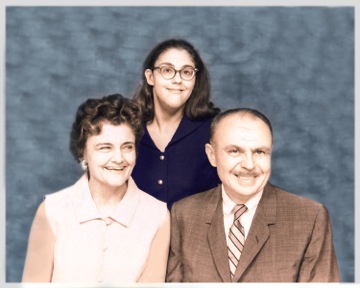
Dorothy and Wallace Savage with their daughter, Dotsy, for whom Dallas Academy was the inspiration. (Photo courtesy of the Savage family)
Like Dorothy, Wallace Savage was a man who knew how to get things done. He was mayor of Dallas from 1948-50, during which he oversaw the opening of the Central Expressway.
Wallace went about securing financing and a location for the new school, while Dorothy searched for faculty equipped to handle this unique set of students. The school opened as Plano Academy for the Achievement of Human Potential in an old storefront on Pearl Street in conjunction with the short-lived University of Plano. It was 1965, the same year The Luke Waites Center for Dyslexia and Learning Disorders opened at Texas Scottish Rite Hospital for Children. Learning disabilities were just becoming widely understood, but very few teachers had been trained in how to instruct students who have drastically different learning abilities.
The school opened with 40 students grades seven through 12, including Dotsy, who ranged in age and ability. As word spread about the specialized education program that offered all of the perks of regular high school, from sweetheart dances to chess club, families from across the globe sought admission. Early yearbooks at the school, which was renamed Dallas Academy shortly after it opened, included student’s hometowns ranging from New York to Oregon and Canada to Saudi Arabia.
Kids that age don’t understand why another kid can’t read the names on her Valentine’s cards to pass them out.
McAlester, who was fresh from college and newly married, remembers having a handful of students live with her during the early years, before the school moved to a larger location with a boarding house. “I would make sure they did their homework, and made their meals and just kept an eye on them,” she says.
While the school attracted families from across the globe, it had no problem drawing students from Dallas. Although it was always a private school, Dallas Academy began receiving state funds after public schools asked to transfer their disabled students to the specially equipped academy. That funding disappeared in 1975 with the federal Education For All Handicapped Children Act, which required all public schools to offer special education.

Dallas Academy is celebrating its 50-year history in the education world. The school, which was established by former Dallas mayor Wallace Savage and his wife, Dorothy, came into fruition after they discovered the lack of schools for students with learning differences. (Photo by Rasy Ran)
“[Public schools] weren’t equipped to handle it, but suddenly they had to do it,” says Jim Richardson, who has been the headmaster of Dallas Academy since 1983, after a few years working in special education with the Dallas Independent School District. All of Dallas Academy’s students who were funded by the state were suddenly moved back to public school, leaving a void in the student body.
It was time for a new era at the school, which began with a new vision.
Since public schools had to become “jack of all trade” facilities for students with a wide range of needs, Dallas Academy decided to focus on high-functioning students with learning disabilities — students who likely would fall through the cracks in conventional curriculum. Instead, they would offer customized curriculum that catered to each student’s specific need, a principle that remains in place today.

Jim Richardson has been headmaster at Dallas Academy since 1983 and spent his whole career in the field of special education. (Photo by Rasy Ran)
Take Kate, a fifth-grader at Dallas Academy and a Lake Highlands resident. Until second grade, she attended public school, with miserable results. Her severe dyslexia made spelling and reading difficult, and kids were often unintentionally cruel.
“Kids that age don’t understand why another kid can’t read the names on her Valentine’s cards to pass them out,” said Kate’s mom, Ashli Robertson. “Her teacher’s loved on her, but she was so frustrated … That last year of public school, we didn’t have a great home life.”
Once Kate moved to Dallas Academy, she stopped getting graded on her spelling because doesn’t accurately reflect her intelligence. She began to succeed in school, and thus she began to love it.
“I think she would have slipped through the cracks in public school,” Robertson said. “She’s a different kid now.”
The school’s focus on students like Kate, who learn in their own way, drew in parents whose kids needed an option that toed the line between special education and conventional schools of the 1970s.
A new location was needed to meet the demand from new students. In 1977 Will Caruth, who leased the land that would house NorthPark Center to Ray Nasher, helped the school secure its current site on Tiffany Way, where the old St. John’s Episcopal Church stood.
Caruth was not the only big name to come out and support the school. More recently, Dallasite John Albers, former CEO of the Dr. Pepper/Seven-Up companies, donated $1 million to fund the gym.
Like the Savages before him, Richardson believes in the importance of offering students a full fleet of extra-curricular activities. “If you were a cheerleader at Lake Highlands High, you can be a cheerleader here. We want them to have all the same opportunities,” he says.
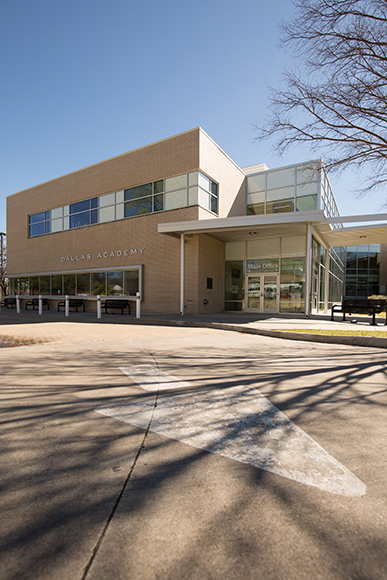
Dallas Academy is celebrating its 50-year history in the education world. The school, which was established by former Dallas mayor Wallace Savage and his wife, Dorothy, came into fruition after they discovered the lack of schools for students with learning differences. (Photo by Rasy Ran)
Those opportunities come at a price. While the school’s success rate cannot be debated — last year 100 percent of students went on to college — it’s annual tuition ranges from $14,000 at the elementary level to $20,000 for high school. “We’ve always operated like a business,” Richardson says.
But the transformation some families experience can’t be understated. “We see families in crisis,” Richardson says, explaining that kids often get depressed when they can’t succeed in public school despite their best efforts. “We get kids who are on Zoloft and their parents are so upset. The kids get here and with in a month, they are happy.”
Special education is exponentially better understood than it was 50 years ago when Dallas Academy first opened. Cutting edge teaching methods now ensure students can learn in a way that works for them, and how to advocate for their own academic success.
As for Dotsy, she still lives with her sister on Swiss Avenue. McAlester says she is still understanding the full impact of her parents’ passion project. On a recent winter day, a former student showed up out of the blue and rang the doorbell. With tears in his eyes, he gushed about how her parents’ efforts ensured him a successful future as a contractor. “He couldn’t read when he got [to school], he was in the fifth-grade,” she says. “He felt like such an outcast before, he said the academy changed his life.”
Originally published in the April 2016 Lake Highlands Advocate.

